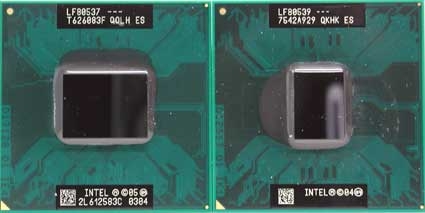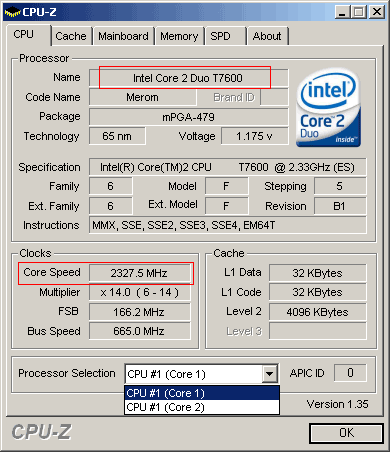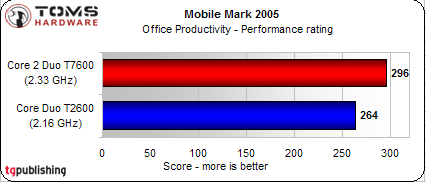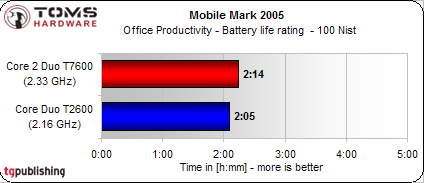UPDATE: First Core 2 Duo T7600 performance and battery benchmarks
Munich (Germany) and Chicago (IL) - Tom's Hardware has received one of the very few available final test units of Intel's Core 2 Duo T-series CPUs, formerly code-named "Merom". During its initial two benchmark runs, the chip delivered first evidence that it can be up to 20% faster than Core Duo ("Yonah"), while consuming less or equal power. Our update includes an slide show with benchmark numbers.
The Core 2 Duo T-series is Intel's third processor to use the firm's new "Core" micro architecture and will follow on the heels of the DP server/workstation CPU Xeon 5100 ("Woodcrest") and the desktop-focused Core 2 Duo E-series ("Conroe"). While Merom was formally announced with Conroe last Thursday (scroll down to see all articles in our launch coverage), the processor won't be available until the second half of August, according to Intel. And if we believe Taiwanese manufacturers, the availability of the processor may not be too overwhelming during the first weeks of its market debut.
Intel's Core 2 Duo T7600 processor (left) and the current Core Duo T2600. The T7600 is clocked at 2.33 GHz, The T2600 at 2.16 GHz.
One of the first final Merom processors arrived at Tom's Hardware's test labs on Friday last week. Over the weekend, Tom's Hardware's engineers began preparing a test system for our benchmark parcours. The tests are far from being complete, but we decided to publish first test results to provide a glimpse on the chip's capabilities in the Mobile Mark and Sysmark disciplines. Mobile Mark 2005 is a benchmark that won't reveal how fast the chip really is, but it provides a good idea how well it runs with office productivity applications and how well it can conserve battery power. Sysmark is a benchmark the measures the performance of real applications and offers an overall performance result as well as numbers that break down into Internet content creation and office productivity.
Detailed results will be published by Tom's Hardware in a comprehensive article soon.
The test system used by Tom's Hardware was built around a 15.4" Asus Z96 multimedia notebook equipped with a 512 MB ATI Radeon X1600 GPU, a 7200 RPM hard drive and 1 GB of DDR2-667 memory. The feature set was an indicator that we wouldn't see any record breaking battery running times; but since Merom uses the same socket as Yonah, we are able to observe the performance of both processors - a Core 2 Duo T7600 and a Core Duo T2600 - in the exact same environment side by side.
Technical data of our T7600 at maximum clock speed
Get Tom's Hardware's best news and in-depth reviews, straight to your inbox.
So, how did the T7600 perform in the first two benchmarks? (see our slide show for detailed numbers)
Mobile Mark 2005
In plain numbers, the 2.33 GHz T7600 achieved 296 Mobile Marks, which is a 12% improvement over the 264 points the 2.16% GHz T2600 achieved. The result is somewhat less than what we expected, as the T7600 is clocked about 8% higher than the 2600, which leaves about 4% of gain from the new architecture.
In fairness, we have to mention that Mobile Mark is not a performance-focused benchmark and uses a somewhat antiquated set of applications that mostly cannot take advantage of the improved multi-threading features in Merom. These applications include Winzip, McAfee Virusscan, Microsoft Word, Excel, Powerpoint and Outlook, Macromedia Flash, Netscape Communicator and Adobe Photoshop. We will have to wait for more benchmark results to see the true performance capability of the processor.
More noteworthy than the performance result is the way the T7600 achieved the performance gain. Despite the fact that the processor is rated at a higher thermal design power than its predecessor (34 watts and 31 watts, respectively), Merom consumed slightly less power during the benchmark run. The exact system ran nine minutes or 7% longer with the Merom chip than with the Core Duo. This result is especially impressive if we consider the fact that Merom packs twice the amount of (power consuming) L2 Cache on its die: The Core 2 Duo T 7600 comes with 4 MB, while the Core Duo T2600 uses 2 MB.
An interesting question is why Merom is able to run more efficiently than Yonah, despite its apparent L2 "disadvantage". In fact, one of Intel's long discussed performance/power statements may finally be kicking in: Not only is the chip more power efficient than the competition, but due its performance advantage, it can finish tasks faster and can shut down parts of the processor more often, Intel claims. This may not only be true when compared to AMD's Turion 64 processors, but with Yonah as well.
The observed 7% difference in battery running time most certainly will fluctuate in upcoming test runs; but the benchmark already reveals that Merom delivers a performance increase over Yonah while consuming less or equal power than Yonah - which we find quite impressive.
Sysmark 2004 SE
Our Merom chip came very close to Intel's claim that Merom runs about 20% faster than Yonah, if we leave the higher clock of the new processor out of consideration. The T2600 ended the test run with 226 points, while the T7600 crossed the finish line - which translates into an overall performance gain of about 17.7%.
The performance increase in the six different categories of the benchmark came in between 5.3% (office productivity, communication) and 25.8% (office productivity, data analysis). If we count in Merom's higher clock speed, then Yonah is actually slightly faster in the "communication" discipline. In every other discipline, Merom is able to post a substantial performance gain over Yonah. Overall improvement in Internet content creation was 18.6%; office productivity accelerated by an average of 14.7%.
Our complete set of benchmarks will break up the performance capabilities of Merom into more detail. Check back for a review on Tom's Hardware soon.
What we can say already today is that Merom is without doubt one impressive piece of silicon. The chip provides visible performance gain over Yonah in all but one category we have tested so far. At the same time, the Merom enabled the test platform to run longer than Yonah, indicating less or equal power consumption, if we adjust our results for common variations of available battery time between test runs. If only the best is good enough for you, it's certainly a good idea to begin counting your dollars.
The Mobile Mark 2005 result indicates that Core Duo notebooks will hold their value for many users for some time: If a notebook has to cope with office productivity applications most of the time, the performance advantage doesn't appear to be dramatic. Count in the premium price of Meroms and the "old" Core Duo may be just what you are looking for in a new notebook this Christmas.
Check back soon for the complete test of the Core 2 Duo T7600 as well as a thorough look into AMD's Turion 64 X2 processor.
Complete Core 2 Duo launch coverage:
Intel is back: Core 2 Duo launches
Core 2 Duo Logo Intel aims to ship 1 million Core 2 Duo processor within seven weeks
TG Daily interviews Intel: "Core is changing the game"
Official: Intel releases Core 2 Duo, Core 2 Extreme
Up to $16,000: Core 2 Duo computers flood the Net
The long road to Conroe
Tom's Hardware: Core 2 Duo smokes AMD's Athlon 64 X2
Intel to launch Merom, Conroe on Thursday
Four AMD dual-core prices now at or near Intel price/performance curve
Technology Background: Will Intel's Core Architecture Close the Technology Gap? (Tom's Hardware)




